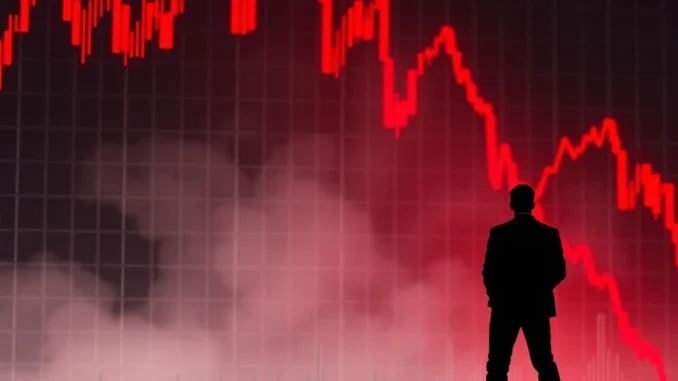
Is the Bull Run Over? Investors are reeling as major U.S. stock indexes experienced a significant downturn today, painting a concerning picture for the financial markets. While the crypto world often dances to its own volatile rhythm, tremors in the traditional stock market can send ripples across all asset classes. Let’s dive into what happened and what it could mean for your investment strategy.
Why Did the Stock Market Crash Today?
While pinpointing the exact cause of a single-day market dip is complex, several factors often contribute to a widespread market downturn. Today’s lower close across the S&P 500, Nasdaq, and Dow Jones suggests a confluence of negative sentiment impacting investor confidence. Here’s a breakdown:
- Economic Uncertainty: Lingering concerns about inflation, rising interest rates, and potential recession continue to weigh heavily on market sentiment. Investors are closely watching economic data releases for clues about the future direction of the economy.
- Geopolitical Tensions: Global events and geopolitical instability can introduce volatility and uncertainty into the markets, leading to investor caution and sell-offs.
- Profit Taking: After periods of market gains, some investors may choose to take profits, leading to downward pressure on stock prices.
- Sector-Specific Weakness: While today’s downturn was broad, weakness in key sectors can drag down the overall market. Analyzing sector performance can provide deeper insights into the reasons behind the decline.
Decoding the Data: A Closer Look at the Market Plunge
Let’s examine the numbers to understand the magnitude of today’s stock market crash in perspective:
| Index | Change | Percentage Change |
|---|---|---|
| S&P 500 | Lower | -0.76% |
| Nasdaq | Lower | -0.18% |
| Dow Jones Industrial Average | Lower | -1.14% |
As you can see, the Dow Jones Industrial Average experienced the steepest decline, while the Nasdaq Composite, often seen as more growth-oriented, saw a comparatively smaller drop. The S&P 500, a broader market indicator, fell in between.
Navigating Investment Risks in a Volatile Market
Periods of investment risks and market volatility are inherent in the financial landscape. Understanding how to navigate these times is crucial for protecting and growing your portfolio. Here are some key considerations:
- Diversification is Key: A well-diversified portfolio across different asset classes can help mitigate risk. Don’t put all your eggs in one basket. Consider spreading investments across stocks, bonds, real estate, and yes, even cryptocurrencies, to reduce the impact of downturns in any single market.
- Long-Term Perspective: Market corrections are a normal part of the economic cycle. Maintaining a long-term investment perspective can help you avoid emotional reactions and impulsive decisions during short-term volatility.
- Dollar-Cost Averaging: Consider using dollar-cost averaging, which involves investing a fixed amount of money at regular intervals, regardless of market fluctuations. This strategy can help reduce the risk of investing a lump sum right before a market downturn.
- Review Your Risk Tolerance: Market downturns are a good time to reassess your risk tolerance. Are you comfortable with the level of volatility in your portfolio? Adjust your asset allocation if necessary to align with your comfort level and financial goals.
- Seek Professional Advice: If you’re unsure how to navigate market volatility, consult with a qualified financial advisor. They can provide personalized guidance based on your individual circumstances.
Economic Uncertainty and the Crypto Connection
While the crypto market operates somewhat independently, it’s not entirely immune to broader economic uncertainty. Traditional financial markets and the cryptocurrency space are becoming increasingly interconnected. Investor sentiment, influenced by events in the stock market, can indirectly impact crypto asset valuations.
For example, a significant stock market downturn might lead some investors to reduce risk across their entire portfolio, potentially leading to outflows from crypto as well. Conversely, in times of extreme economic instability, some investors may view cryptocurrencies as a hedge against traditional market turmoil, although this thesis remains debated.
Financial Markets in Flux: What’s Next?
Predicting the future of the financial markets with certainty is impossible. However, staying informed and prepared is within your control. Keep an eye on economic indicators, central bank policies, and geopolitical developments. Volatility may persist in the short term, but history suggests that markets tend to recover over time.
In Conclusion: Stay Informed, Stay Prepared
Today’s lower close in major U.S. stock indexes serves as a stark reminder of the inherent volatility in financial markets. For cryptocurrency investors, it’s a signal to remain vigilant and understand the interconnectedness of global finance. By staying informed, diversifying your portfolio, and maintaining a long-term perspective, you can navigate these uncertain times and position yourself for future opportunities. Don’t panic, prepare.



